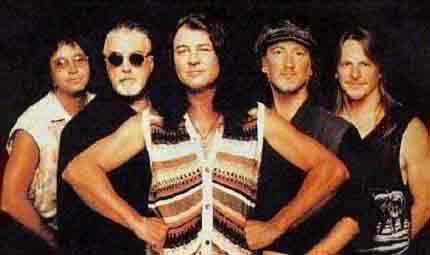  Go Home Go Home
  POP POP
 Boyzone Boyzone
 Cliff Richard Cliff Richard
 Enigma Enigma
 Kenny G Kenny G
 MLTR MLTR
 Westlife Westlife
 Savage Garden Savage Garden
 Others.. Others..
 ROCK ROCK
 AC/DC AC/DC
 Aerosmith Aerosmith
 Bryan Adams Bryan Adams
 Bruce Springsteen Bruce Springsteen
 Def Leppard Def Leppard
 Deep Purple Deep Purple
 Scorpions Scorpions
 Others.. Others..
 METAL METAL
 Black Sabbath Black Sabbath
 Cannibal Corpse Cannibal Corpse
 Iron Maiden Iron Maiden
 Megadeth Megadeth
 Metallica Metallica
 Pantera Pantera
 Sepultura Sepultura
 Six Feet Under Six Feet Under
 Slayer Slayer
 Slipknot Slipknot
 Type o Negative Type o Negative
 Others.. Others..
 COUNTRY COUNTRY
 Don Williams Don Williams
 Dan Seals Dan Seals
 Kenny Rogers Kenny Rogers
 Neil Diamond Neil Diamond
 Shania Twain Shania Twain
 Others.. Others..
|
 
THE BAND :
BIOGRAPHY : Deep Purple survived a seemingly endless series of lineup changes and a dramatic mid-career shift from grandiose progressive rock to ear-shattering heavy metal to emerge as a true institution of the British hard rock community; once credited in the Guinness Book of World Records as the globe's loudest band, their revolving-door roster launched the careers of performers including Ritchie Blackmore, David Coverdale, and Ian Gillan. Deep Purple was formed in Hertford, England in 1968, with an inaugural lineup that featured guitarist Blackmore, vocalist Rod Evans, bassist Nick Simper, keyboardist Jon Lord, and drummer Ian Paice. Initially dubbed Roundabout, the group was first assembled as a session band for ex-Searchers drummer Chris Curtis but quickly went their own way, touring Scandinavia before beginning work on their debut LP, Shades of Deep Purple. The most pop-oriented release of their career, the album generated a Top Five American hit with its reading of Joe South's "Hush" but otherwise went unnoticed at home. The Book of Taliesyn followed (in the U.S. only) in 1969, again cracking the U.S. Top 40 with a cover of Neil Diamond's "Kentucky Woman." With their self-titled third LP, Deep Purple's ambitions grew, however; the songs reflecting a new complexity and density as Lord's classically influenced keyboards assumed a much greater focus. Soon after the album's release, their American label Tetragrammaton folded, and with the dismissals of Evans and Simper, the band started fresh, recruiting singer Ian Gillan and bassist Roger Glover from the ranks of the pop group Episode Six. The revamped Deep Purple's first album, 1970's Concerto for Group and Orchestra, further sought to fuse rock and classical music. After completing 1974's Stormbringer, Blackmore left Deep Purple to form Rainbow with vocalist Ronnie James Dio; his replacement was ex-James Gang guitarist Tommy Bolin, who made his debut on Come Taste the Band. All the changes clearly took their toll, however, and following a farewell tour the group dissolved in 1976, with Coverdale going on to form Whitesnake; Bolin died of a drug overdose later in the year. The classic lineup of Blackmore, Gillan, Lord, Glover and Paice reunited Deep Purple in 1984 for a new album, the platinum smash Perfect Strangers; The House of Blue Light followed three years later, but as past tensions resurfaced, Gillan again exited in mid-1989. Onetime Rainbow vocalist Joe Lynn Turner was recruited for 1990's Slaves and Masters before Gillan again rejoined to record The Battle Rages On... - an apt title as Blackmore quit the group midway through the supporting tour, to be temporarily replaced by Joe Satriani. In 1994, Steve Morse took over the guitar slot, fresh from a stint in Kansas; the revitalized group returned to the studio for 1996's Purpendicular, which proved a success among the Purple faithful. 1998's Abandon followed, as well as a 1999 orchestral performance released the following year as Live at the Royal Albert Hall. |
  HINDI MUSIC HINDI MUSIC
 Film Music Film Music
 Ghazals Ghazals
 Others.. Others..
 THE LEGENDS THE LEGENDS
 Gulzar Gulzar
 Kishore Kumar Kishore Kumar
 R.D.Burman R.D.Burman
  View View
  Play Some Cool Games Play Some Cool Games
  COOL DOWNLOADS COOL DOWNLOADS
 Screensavers Screensavers
 Wallpapers Wallpapers
 Winamp Skins Winamp Skins
  Sign The Guest book Sign The Guest book
  Know Me.. Know Me..
  Tell a friend.. Tell a friend..
|